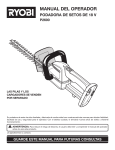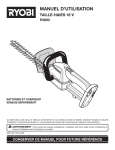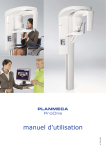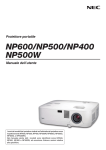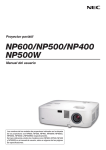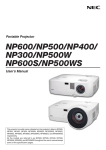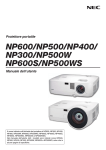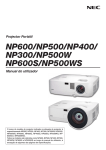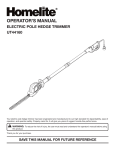Download Ryobi Outdoor P2600 User's Manual
Transcript
OPERATOR’S MANUAL 18 VOLT HEDGE TRIMMER P2600 BATTERIES AND CHARGERS SOLD SEPARATELY Your hedge trimmer has been engineered and manufactured to our high standard for dependability, ease of operation, and operator safety. When properly cared for, it will give you years of rugged, trouble-free performance. WARNING: To reduce the risk of injury, the user must read and understand the operator’s manual before using this product. Thank you for your purchase. SAVE THIS MANUAL FOR FUTURE REFERENCE TABLE OF CONTENTS n Introduction ..................................................................................................................................................................... 2 �n General Safety Rules ....................................................................................................................................................... 3 �n Specific Safety Rules....................................................................................................................................................... 4 n Safety Rules for Charger ................................................................................................................................................. 5 �n Symbols........................................................................................................................................................................ 6-7 �n Features........................................................................................................................................................................... 8 �n Assembly ......................................................................................................................................................................... 9 �n Operation.................................................................................................................................................................. 10-13 n Maintenance ............................................................................................................................................................. 14-17 �n Parts Ordering / Service ................................................................................................................................................ 18 INTRODUCTION This tool has many features for making its use more pleasant and enjoyable. Safety, performance, and dependability have been given top priority in the design of this product making it easy to maintain and operate. 2 GENERAL SAFETY RULES n Keep hands, face, and feet at a safe distance from moving parts. Do not touch or try to stop the cutting blades when they are moving. n Do not use tool if switch does not turn it on or off. A tool that cannot be controlled with the switch is dangerous and must be repaired. WARNING! READ AND UNDERSTAND ALL INSTRUCTIONS. Failure to follow all instructions listed below, may result in electric shock, fire and/or serious personal injury. READ ALL INSTRUCTIONS n Avoid accidental starting. Be sure switch is in the locked or off position before inserting battery pack. Carrying tools with your finger on the switch or inserting the battery pack into a tool with the switch on invites accidents. n Know your tool. Read and understand the operator’s manual and observe the warnings and instruction labels affixed to the tool. n Stay alert, watch what you are doing and use common sense when operating a power tool. Do not use tool while tired or under the influence of drugs, alcohol, or medication. A moment of inattention while operating power tools may result in serious personal injury. n Avoid dangerous environments. Do not use the tool in damp or wet locations. Do not operate the hedge trimmer in rain. n Maintain tools with care. Keep cutting tools sharp and clean. Properly maintained tools with sharp cutting edges are less likely to bind and are easier to control. n Do not allow children or untrained individuals to use this unit. n Check for misalignment or binding of moving parts, breakage of parts, and any other condition that may affect the tool’s operation. If damaged, have the tool serviced before using. A guard or any other part that is damaged should be carefully checked to determine that it will operate properly and perform its intended function. Many accidents are caused by poorly maintained tools. n Wear safety glasses or goggles that are marked to comply with ANSI Z87.1-1989 standards when operating this unit. n Protect your lungs. Wear a face or dust mask if the operation is dusty. Following this rule will reduce the risk of serious personal injury. n Dress properly. Do not wear loose clothing or jewelry. Contain long hair. Loose clothes, jewelry, or long hair can be caught in moving parts. n Keep the tool and its handle dry, clean and free from oil and grease. Always use a clean cloth when cleaning. Never use brake fluids, gasoline, petroleumbased products, or any strong solvents to clean your tool. Following this rule will reduce the risk of loss of control and deterioration of the enclosure plastic. n Wear heavy long pants, boots, and gloves. Do not wear loose fitting clothing, short pants, or jewelry of any kind. Do not go barefoot. n Secure long hair so it is above shoulder level to prevent entanglement in any moving parts. n To avoid the risk of electric shock, do not operate unit in damp or wet locations. n Keep all bystanders, children, and pets at least 50 feet away. n Use only accessories that are recommended by the manufacturer for your model. Accessories that may be suitable for one tool may create a risk of injury when used on another tool. n Do not force tool. Use the correct tool for your application. The correct tool will do the job better and safer at the rate for which it is designed. n Tool service must be performed only by qualified repair personnel. Service or maintenance performed by unqualified personnel may result in a risk of injury. n Do not overreach. Keep proper footing and balance at all times. Proper footing and balance enables better control of the tool in unexpected situations. Do not use on a ladder or unstable support. n When servicing a tool, use only identical replacement parts. Follow instructions in the Maintenance section of this manual. Use of unauthorized parts or failure to follow Maintenance instructions may create a risk of shock or injury. n Do not operate in poor lighting. 3 SPECIFIC SAFETY RULES n Before starting the hedge trimmer, make sure the blade is not in contact with any object. MODEL BATTERY PACK (P100) CHARGER (P110) P2600 130255004 1423701, 140237023 or 130224028 or 140237021 n To reduce the risk of explosion and possible injury, DO NOT place battery units or their batteries near fire or heat. n Do not mutilate the battery pack. Released electrolyte is corrosive and may cause damage to the eyes or skin. It may be toxic if swallowed. n Stop the unit, remove the battery pack, and make sure the blade has stopped before setting the unit down. n Never cut any material with a diameter larger than 3/8 in. n DANGER: Risk of cut. Keep hands away from blades. Do not attempt to remove cut material or hold material to be cut when blades are moving. Keep both hands on handles when power is on. Make sure battery pack is removed and the trigger is released when clearing jammed material from blades. Do not grasp the exposed cutting blades or cutting edges when picking up or holding the unit. n Blades coast after unit is turned off. n Batteries vent hydrogen gas and can explode in the presence of a source of ignition, such as a pilot light. To reduce the risk of serious personal injury, never use any cordless product in the presence of open flame. An exploded battery pack can propel debris and chemical. If exposed, flush with water immediately. n Do not charge unit in a damp or wet location. Following this rule will reduce the risk of electric shock. n For best results, your battery unit should be charged in a location where the temperature is more than 50°F (10°C) but less than 100°F (38°C). Do not store outside or in vehicles. n Always stop the motor when cutting is delayed or when walking from one cutting location to another. n Keep unit clean of grass clippings and other materials. They may become lodged in the cutting blades. n Store the unit inside in a dry place, either locked up or up high to prevent unauthorized use or damage. Keep out of the reach of children or untrained individuals. n Replace blade cover when unit is not in use. n Never douse or squirt the unit with water or any other liquid. Keep handles dry, clean, and free from debris. Clean after each use; see Storage instructions. n Secure the unit while transporting. n Under extreme usage or temperature conditions, battery pack leakage may occur. If liquid comes in contact with your skin, wash immediately with soap and water, then neutralize with lemon juice or vinegar. If liquid gets into your eyes, flush them with clean water for at least 10 minutes, then seek immediate medical attention. n A damaged battery pack is subject to explosion. To avoid serious personal injury, properly dispose of a damaged battery pack. BATTERY SAFETY n Battery operated units do not have to be plugged into an electrical outlet; therefore, they are always in operating condition. Be aware of possible hazards even when unit is not operating. n Remove the battery pack before making any adjustments, cleaning, storing, or removing material from the unit, or when not in use. n A battery pack must be recharged only with the specified charger for the battery pack. A charger that may be suitable for one type of battery pack may create a risk of fire when used with another battery pack. Use battery pack only with charger listed. n Do not dispose of batteries in a fire. The cell may explode. Batteries should be recycled. Consult your local waste authority for information regarding available recycling and/or disposal options. n When battery pack is not in use, keep it away from other metal objects like: paper clips, coins, keys, nails, screws, or other small metal objects that can make a connection from one terminal to another. Shorting the battery pack terminals together may cause sparks, burns, or a fire. 4 SAFETY RULES FOR CHARGER n An extension cord should not be used unless absolutely necessary. Use of improper extension cord could result in a risk of fire and electric shock. If extension cord must be used, make sure: WARNING! READ AND UNDERSTAND ALL INSTRUCTIONS. Failure to follow all instructions listed below, may result in electric shock, fire and/or serious personal injury. a. That pins on plug of extension cord are the same number, size and shape as those of plug on charger. n Before using battery charger, read all instructions and cautionary markings in this manual, on battery charger, battery, and product using battery to prevent misuse of the products and possible injury or damage. b. That extension cord is properly wired and in good electrical condition; and c. That wire size is large enough for AC ampere rating of charger as specified below: CAUTION: To reduce the risk of electric shock or damage to the charger and battery, charge only nickel-cadmium rechargeable batteries as specifically designated on your charger. Other types of batteries may burst, causing personal injury or damage. Cord Length (Feet) 25' 50' 100' Cord Size (AWG) 16 16 16 NOTE: AWG = American Wire Gauge n Do not operate charger with a damaged cord or plug, which could cause shorting and electric shock. If damaged, have the charger replaced by an authorized serviceman. n Do not use charger outdoors or expose to wet or damp conditions. Do not charge in rain. Water entering charger will increase the risk of electric shock. n Do not operate charger if it has received a sharp blow, been dropped, or otherwise damaged in any way. Take it to an authorized serviceman for electrical check to determine if the charger is in good working order. n Use of an attachment not recommended or sold by the battery charger manufacturer may result in a risk of fire, electric shock, or injury to persons. Following this rule will reduce the risk of electric shock, fire, or serious personal injury. n Do not disassemble charger. Take it to an authorized serviceman when service or repair is required. Incorrect reassembly may result in a risk of electric shock or fire. n Unplug charger from outlet before attempting any maintenance or cleaning to reduce the risk of electric shock. n Do not abuse cord or charger. Never use the cord to carry the charger. Do not pull the charger cord rather than the plug when disconnecting from receptacle. Damage to the cord or charger could occur and create an electric shock hazard. Replace damaged cords immediately. n Disconnect charger from the power supply when not in use. This will reduce the risk of electric shock or damage to the charger if metal items should fall into the opening. It also will help prevent damage to the charger during a power surge. n Make sure cord is located so that it will not be stepped on, tripped over, come in contact with sharp edges or moving parts or otherwise subjected to damage or stress. This will reduce the risk of accidental falls, which could cause injury, and damage to the cord, which could result in electric shock. n Risk of electric shock. Do not touch uninsulated portion of output connector or uninsulated battery terminal. n Save these instructions. Refer to them frequently and use them to instruct others who may use this tool. If you loan someone this tool, loan them these instructions also to prevent misuse of the product and possible injury. n Keep cord and charger from heat to prevent damage to housing or internal parts. n Do not let gasoline, oils, petroleum-based products, etc. come in contact with plastic parts. They contain chemicals that can damage, weaken, or destroy plastic. 5 SYMBOLS Some of the following symbols may be used on this tool. Please study them and learn their meaning. Proper interpretation of these symbols will allow you to operate the tool better and safer. SYMBOL NAME DESIGNATION/EXPLANATION V Volts Voltage A Amperes Current Hz Hertz Frequency (cycles per second) W Watt Power Minutes Time Alternating Current Type of current Direct Current Type or a characteristic of current No Load Speed Rotational speed, at no load Class II Construction Double-insulated construction Per Minute Revolutions, strokes, surface speed, orbits etc., per minute Wet Conditions Alert Do not expose to rain or use in damp locations. Read The Operator’s Manual To reduce the risk of injury, user must read and understand operator’s manual before using this product. Eye Protection Wear eye protection when operating this equipment. Safety Alert Precautions that involve your safety. Gloves Wear non-slip, heavy-duty protective gloves when handling the blades. Moving Parts Keep hands away from moving parts. Keep Bystanders Away Keep all bystanders at least 50 ft. away. Kickback DANGER! Beware of kickback. Hot Surfaces To reduce the risk of injury or damage, avoid contact with any hot surface. Electric Shock Failure to use in dry conditions and to observe safe practices can result in electric shock. Sharp Blade Sharp cutting blades. To prevent serious injury, do not touch cutting blades. min no .../min 50' 15m 6 SYMBOLS The following signal words and meanings are intended to explain the levels of risk associated with this product. SYMBOL SIGNAL MEANING DANGER: Indicates an imminently hazardous situation, which, if not avoided, will result in death or serious injury. WARNING: Indicates a potentially hazardous situation, which, if not avoided, could result in death or serious injury. CAUTION Indicates a potentially hazardous situation, which, if not avoided, may result in minor or moderate injury. CAUTION (Without Safety Alert Symbol) Indicates a situation that may result in property damage. SERVICE WARNING: Servicing requires extreme care and knowledge and should be performed only by a qualified service technician. For service we suggest you return the product to your nearest AUTHORIZED SERVICE CENTER for repair. When servicing, use only identical replacement parts. To avoid serious personal injury, do not attempt to operate this product until you read thoroughly and understand completely the operator's manual. Save this operator’s manual and review frequently for continuing safe operation and instructing others who may use this product. WARNING: The operation of any power tool can result in foreign objects being thrown into your eyes, which can result in severe eye damage. Before beginning power tool operation, always wear safety goggles or safety glasses with side shields, or a full face shield when needed. We recommend Wide Vision Safety Mask for use over eyeglasses or standard safety glasses with side shields. Always use eye protection which is marked to comply with ANSI Z87.1. SAVE THESE INSTRUCTIONS 7 FEATURES PRODUCT SPECIFICATIONS Motor .................................................................. 18 Volt DC Blade Length .............................................................. 18 in. Cutting Capacity........................................................ 3/8 in. Charger Input ................................... 120 V, 60 Hz, AC only Charge Rate ..............................................................1 hour Net Weight................................................................. 5.2 lb. BLADE COVER GUARD TRIGGER LOCK BLADES Fig. 1 KNOW YOUR HEDGE TRIMMER GUARD See Figure 1. Before attempting to use this product, familiarize yourself with all operating features and safety rules. The guard helps to deflect chips or other debris away from the operator’s hands. TRIGGER LOCK BLADE COVER The trigger lock prevents unintentional starting of the hedge trimmer. The blade cover keeps the operator from coming in contact with the sharp blades when the tool is not in use. It also helps keep the blades from being nicked or damaged when the tool is in storage. 8 ASSEMBLY UNPACKING WARNING: This product has been shipped completely assembled. If any parts are damaged or missing do not operate this tool until the damaged or missing parts are replaced. Failure to do so could result in possible serious personal injury. n Carefully remove the tool and any accessories from the box. Make sure that all items listed in the packing list are included. n Inspect the tool carefully to make sure no breakage or damage occurred during shipping. n Do not discard the packing material until you have carefully inspected and satisfactorily operated the tool. n If any parts are damaged or missing, please call 1-800-860-4050 for assistance. WARNING: Do not attempt to modify this tool or create accessories not recommended for use with this tool. Any such alteration or modification is misuse and could result in a hazardous condition leading to possible serious personal injury. PACKING LIST Hedge Trimmer Blade Cover WARNING: Operator’s Manual Warranty Registration Card To prevent accidental starting that could cause serious personal injury, always remove the battery pack from the tool when assembling parts. 9 OPERATION NOTE: Batteries will not reach full charge the first time they are charged. Allow several cycles (operation followed by recharging) for them to become fully charged. WARNING: Do not allow familiarity with tools to make you careless. Remember that a careless fraction of a second is sufficient to inflict serious injury. CHARGING A COOL BATTERY PACK If battery pack is within normal temperature range, the red LED on charger will come on. NOTE: If the charger does not charge the battery pack under normal circumstances, return both the battery pack and charger to your nearest Authorized Service Center for electrical check. n Charge the battery pack only with the charger provided. n Make sure the power supply is normal household voltage, 120 volts, 60 Hz, AC only. n Connect the charger to the power supply. n Place the battery pack in the charger aligning raised rib on the battery pack with the groove in the charger. See Figure 2. n Press down on the battery pack to be sure contacts on the battery pack engage properly with contacts in the charger. n Normally the red LED on charger will come on. This indicates the charger is in fast charging mode. n Red LED should remain on for approximately 1 hour then the green LED will come on. Green LED on indicates battery pack is fully charged and charger is in maintenance charge mode. NOTE: The green LED will remain on until the battery pack is removed from the charger or charger is disconnected from the power supply. n If both yellow and green LEDs come on, this indicates a deeply discharged or defective battery pack. Allow the battery pack to remain in the charger for 15 to 30 minutes. When the battery pack reaches normal voltage range, the red LED should come on. If the red LED does not come on after 30 minutes, this may indicate a defective battery pack that should be replaced. n After normal usage, a minimum of 1 hour of charging time is required to fully recharge battery pack. n The battery pack will become slightly warm to the touch while charging. This is normal and does not indicate a problem. n Do not place the charger and battery pack in an area of extreme heat or cold. They will work best at normal room temperature. NOTE: The charger and battery pack should be placed in a location where the temperature is more than 50°F but less than 100°F. n When batteries become fully charged, unplug the charger from power supply and remove the battery pack. WARNING: Always wear safety goggles or safety glasses with side shields when operating tools. Failure to do so could result in objects being thrown into your eyes, resulting in possible serious injury. WARNING: Do not use any attachments or accessories not recommended by the manufacturer of this tool. The use of attachments or accessories not recommended can result in serious personal injury. APPLICATIONS You may use this tool for the purposes listed below: n Trimming and shaping hedges and shrubbery CAUTION: If at any point during the charging process none of the LEDs are lit, remove the battery pack from the charger to avoid damaging the product. DO NOT insert another battery. Return the charger and battery to your nearest service center for service or replacement. LED FUNCTIONS OF CHARGER LED WILL BE ON TO INDICATE STATUS OF CHARGER AND BATTERY PACK: n Red LED on = Fast charging mode. n Green LED on = Fully charged and in maintenance charge mode. n Green LED on = When battery pack is inserted into charger, indicates hot battery pack or that battery pack is out of normal temperature range. n Yellow and Green LEDs on = Deeply discharged or defective battery pack. n No LED on = Defective charger or battery pack. CHARGING THE BATTERY PACK Battery packs for this tool are shipped in a low charge condition to prevent possible problems. Therefore, you should charge it until the green LED on the front of the charger comes on. 10 OPERATION CHARGING A HOT BATTERY PACK P100 BATTERY PACK When using the tool continuously, the batteries in the battery pack will become hot. You should let a hot battery pack cool down for approximately 30 minutes before attempting to recharge. When the battery pack becomes discharged and is hot, this will cause the green LED to come on instead of the red LED. After 30 minutes, reinsert the battery pack in the charger. If the green LED continues to remain on, return battery pack to your nearest Authorized Service Center for checking or replacing. NOTE: This situation only occurs when continuous use of the tool causes the batteries to become hot. It does not occur under normal circumstances. Refer to CHARGING A COOL BATTERY PACK for normal recharging of batteries. If the charger does not charge your battery pack under normal circumstances, return both the battery pack and charger to your nearest Authorized Service Center for electrical check. P110 CHARGER RED LED TO INSTALL BATTERY PACK YELLOW LED See Figure 3. n Place the battery pack in the hedge trimmer. Align the raised rib on the battery pack with groove in the hedge trimmer’s battery port. n Make sure the latches on each side of the battery pack snap in place and that the battery pack is secured in the hedge trimmer before beginning operation. BATTERY PACK GREEN LED Fig. 2 BATTERY PORT CAUTION: When placing battery pack in the tool, be sure raised rib on battery pack aligns with the bottom of the tool and latches into place properly. Improper installation of the battery pack can cause damage to internal components. TO REMOVE BATTERY PACK See Figure 3. n Locate the latches on the side of the battery pack and depress both sides to release the battery pack from the hedge trimmer. LATCHES Fig. 3 11 OPERATION WARNING: Battery tools are always in operating condition. Therefore, switch should always be locked when not in use or carrying at your side. STARTING THE HEDGE TRIMMER See Figure 4. n Remove the blade cover. n Press and hold the trigger lock. n Depress the switch trigger. n Release the trigger lock. Continue to depress the trigger for extended operation. TRIGGER LOCK STOPPING THE HEDGE TRIMMER See Figure 4. n Release the switch trigger to stop the hedge trimmer. SWITCH TRIGGER Fig. 4 n Upon release of the switch trigger, the trigger lock will automatically reset to the locked position. HOLDING THE HEDGE TRIMMER See Figure 5. The unit has both a front and rear handle. With the blade directed away from you, hold the unit by both handles. WARNING: Always keep both hands on the hedge trimmer handles. Never hold shrubs with one hand and operate the hedge trimmer with the other. Failure to heed this warning may result in serious injury. Fig. 5 12 OPERATION OPERATING TIPS See Figures 6 - 7. DANGER �� �� � If blade jams on any electrical cord or line, DO NOT TOUCH THE BLADE! IT CAN BECOME ELECTRICALLY LIVE AND VERY DANGEROUS. Continue to hold the hedge trimmer by the insulated rear handle or lay it down and away from you in a safe manner. Disconnect the electrical service to the damaged line or cord before attempting to free the blade from the line or cord. Failure to heed this warning will result in serious personal injury or possible death. Fig. 6 WARNING: Clear the area to be cut before each use. Remove all objects such as cords, lights, wire, or string which can become entangled in the cutting blade and create a risk of serious personal injury. n Before starting the hedge trimmer, hold the unit with both hands with the cutting blades directed away from you. Always use the hedge trimmer properly. n Do not force the hedge trimmer through heavy shrubbery. This can cause the blades to bind and slow down. If the blades slow down, reduce the pace. n Do not try to cut stems or twigs that are larger than 3/8 in. thick, or those obviously too large to feed into the cutting blade. Use a non-powered hand saw or pruning saw to trim large stems. Fig. 7 n If blades do become jammed, stop the motor, allow the blades to stop and remove the battery pack before attempting to remove the obstruction. n If desired, you can use a string to help cut your hedge level. Decide how high you want the hedge. Then, stretch a piece of string along the hedge at this height. Trim the hedge just above this guide line of string. Trim the side of a hedge so that it will be slightly narrower at the top. More of the hedge will be exposed when shaped this way, and it will be more uniform. n Wear gloves when trimming thorny or prickly growth. n When trimming new growth, use a wide sweeping action, so that the stems are fed directly into the cutting blade. Older growth will have thicker stems and will be trimmed easiest by using a sawing movement. 13 MAINTENANCE WARNING: WARNING: When servicing, use only identical replacement parts. Use of any other parts may create a hazard or cause product damage. Do not at any time let brake fluids, gasoline, petroleumbased products, penetrating oils, etc., come in contact with plastic parts. Chemicals can damage, weaken or destroy plastic which may result in serious personal injury. WARNING: Only the parts shown on the parts list are intended to be repaired or replaced by the customer. All other parts should be replaced at an Authorized Service Center. Always wear safety goggles or safety glasses with side shields during power tool operation or when blowing dust. If operation is dusty, also wear a dust mask. TRANSPORTING AND STORING n Always place the blade cover on the blade before storing or transporting the hedge trimmer. Use caution to avoid the sharp teeth of the blade. WARNING: To avoid serious personal injury, always remove the battery pack from the tool when cleaning or performing any maintenance. n Clean the hedge trimmer thoroughly before storing. Store the hedge trimmer indoors, in a dry place that is inaccessible to children. Keep away from corrosive agents such as garden chemicals and de-icing salts. GENERAL MAINTENANCE Avoid using solvents when cleaning plastic parts. Most plastics are susceptible to damage from various types of commercial solvents and may be damaged by their use. Use clean cloths to remove dirt, dust, oil, grease, etc. BLADE REPLACEMENT BATTERIES BATTERY PACK REMOVAL AND PREPARATION FOR RECYCLING When replacing the blade on this unit, use only replacement blade part no. 3013214. The battery pack for this tool is equipped with nickel-cadmium rechargeable batteries. Length of service from each charging will depend on the type of work you are doing. The batteries in this tool have been designed to provide maximum trouble-free life. However, like all batteries, they will eventually wear out. Do not disassemble battery pack and attempt to replace the batteries. Handling of these batteries, especially when wearing rings and jewelry, could result in a serious burn. To obtain the longest possible battery life, we suggest the following: To preserve natural resources, please recycle or dispose of batteries properly. This product contains nickel-cadmium batteries. Local, state or federal laws may prohibit disposal of nickel-cadmium batteries in ordinary trash. Consult your local waste authority for information regarding available recycling and/or disposal options. n Remove the battery pack from the charger once it is fully charged and ready for use. WARNING: Upon removal, cover the battery pack’s terminals with heavy-duty adhesive tape. Do not attempt to destroy or disassemble battery pack or remove any of its components. Nickel-cadmium batteries must be recycled or disposed of properly. Also, never touch both terminals with metal objects and/or body parts as short circuit may result. Keep away from children. Failure to comply with these warnings could result in fire and/or serious injury. For battery storage longer than 30 days: n Store the battery pack where the temperature is below 80°F. n Store battery packs in a “discharged” condition. 14 MAINTENANCE WARNING: BLADE COVER SCREWS Blades are sharp. When handling the blade assembly, wear non-slip, heavy-duty protective gloves. Do not place your hand or fingers between blades or in any position where they could get pinched or cut. NEVER touch blades or service unit with battery pack installed. REPLACING BLADES See Figures 8 - 9. Periodically inspect the blades for damage and wear. Always use the manufacturer’s specified replacement blades. REMOVING THE BLADE n Remove the battery pack from the hedge trimmer. BLADE COVER n Place the hedge trimmer upside down on a workbench and remove the four (4) blade cover screws. n Remove the blade cover. n Remove the bar plate from the two pins. n Remove the retaining ring, washer, and retaining plate. Fig. 8 n Align the cams. NOTE: The yokes cannot be lifted unless they clear the lip of the cams. BLADE SCREWS BAR PLATE n Remove the four (4) blade screws. n Each blade has an oval yoke attached at one end. Slide the blades into position so the yokes align. Remove the blade from the housing. CUTTER BLADE ASSEMBLY INSTALLING A NEW BLADE �Before installing a new blade, apply a lithium-based grease to the areas indicated. n Align the cams. RETAINING RING WASHER RETAINING PLATE YOKES n Place the new blade on the housing and align the yokes to drop into place. Rotate the blade so that it drops past the lower cam. APPLY GREASE TO THESE AREAS NOTE: When properly aligned, the blade assembly fits in the recessed slot in the motor housing. CAMS n Reinstall the four (4) blade screws and tighten securely. n Reinstall the retaining plate, washer, and retaining ring. n Reinstall the bar plate over the two pins. n Install the blade cover using the four (4) blade cover screws. Tighten securely. PINS Fig. 9 WARNING: Make sure the bottom plate is replaced before inserting the battery pack and starting the hedge trimmer. Failure to do so will expose internal parts, which could cause an accident or electrical shock, resulting in serious injury. NOTE: If binding occurs after replacing the blade assembly, repeat the steps under Removing the Blade and Installing the Blade. 15 MAINTENANCE LUBRICATING THE BLADE See Figure 10. For easier operation and longer blade life, lubricate the hedge trimmer blade before and after each use. n Remove the battery pack from the hedge trimmer. n Lay the hedge trimmer on a flat surface. Apply light weight machine oil along the edge of the top blade. If you will be using the hedge trimmer for an extended period, it is advisable to oil the blade during use. NOTE: Do not oil while the hedge trimmer is running. n Stop the hedge trimmer. n Remove the battery pack. n Lubricate the hedge trimmer as described above. n Reinstall the battery pack and resume use. SHARPENING THE BLADE See Figure 11. n Allow the blades of the hedge trimmer to come to a stop in the position shown. This will allow clearance for the file between the cutter teeth and the guard teeth. Fig. 10 n Remove the battery pack from the hedge trimmer. n Clamp the blade assembly in a vise and file the exposed cutting surface of each blade tooth with an 8 in. smooth round file, 1/4 in. or 7/32 in. in diameter. Be sure to retain the original angle of the tooth when filing. CUTTING BLADE GUARD n Remove the hedge trimmer from the vise, replace the battery pack, and restart the hedge trimmer. Allow the blades of the hedge trimmer to come to a stop so that the unsharpened edges of the cutter blade teeth are exposed. n Remove battery pack from hedge trimmer and repeat the sharpening procedure as described above. Fig. 11 16 MAINTENANCE CLEANING THE HEDGE TRIMMER n Slide the blade cover over the blade. n Remove the battery pack. n Clean dirt and debris from the body of the hedge trimmer, using a damp cloth with a mild detergent. NOTE: Do not use any strong detergents on the plastic housing or the handle. They can be damaged by certain aromatic oils such as pine and lemon, and by solvents such as kerosene. BLADE COVER n Moisture can cause a shock hazard. Wipe off any moisture with a soft dry cloth. n Use a small brush or the air discharge of a small vacuum cleaner brush to clear dust or debris from the air vents on the motor housing. STORING THE HEDGE TRIMMER See Figure 12. n Clean the hedge trimmer thoroughly before storing. Store the hedge trimmer in a dry, well-ventilated place that is inaccessible to children. Keep away from corrosive agents such as garden chemicals and de-icing salts. Fig. 12 n Always place the blade cover on the cutting blades before storing. 17 OPERATOR’S MANUAL 18 VOLT HEDGE TRIMMER P2600 • SERVICE Now that you have purchased your tool, should a need ever exist for repair parts or service, simply contact your nearest Authorized Service Center. Be sure to provide all pertinent facts when you call or visit. Please call 1-800-860-4050 for your nearest Authorized Service Center. You can also check our web site at www.ryobitools.com for a complete list of Authorized Service Centers. • MODEL NO. AND SERIAL NO. The model number of this tool will be found on a plate attached to the motor housing. Please record the model number and serial number in the space provided below. • HOW TO ORDER REPAIR PARTS When ordering repair parts, always give the following information: • MODEL NUMBER • SERIAL NUMBER P2600 Ryobi® is a registered trademark of Ryobi® Limited used under license. RYOBI TECHNOLOGIES, INC. 1428 Pearman Dairy Road, Anderson, SC 29625 Post Office Box 1207, Anderson, SC 29622-1207 Phone 1-800-860-4050 www.ryobitools.com 983000-846 10-05 18


















